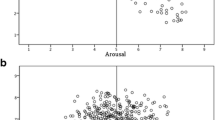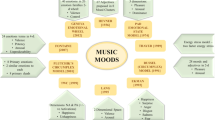Abstract
Recent studies have demonstrated a close relationship between computational acoustic features and neural brain activities, and have largely advanced our understanding of auditory information processing in the human brain. Along this line, we proposed a multidisciplinary study to examine whether power spectral density (PSD) profiles can be decoded from brain activities during naturalistic auditory experience. The study was performed on a high resolution functional magnetic resonance imaging (fMRI) dataset acquired when participants freely listened to the audio-description of the movie “Forrest Gump”. Representative PSD profiles existing in the audio-movie were identified by clustering the audio samples according to their PSD descriptors. Support vector machine (SVM) classifiers were trained to differentiate the representative PSD profiles using corresponding fMRI brain activities. Based on PSD profile decoding, we explored how the neural decodability correlated to power intensity and frequency deviants. Our experimental results demonstrated that PSD profiles can be reliably decoded from brain activities. We also suggested a sigmoidal relationship between the neural decodability and power intensity deviants of PSD profiles. Our study in addition substantiates the feasibility and advantage of naturalistic paradigm for studying neural encoding of complex auditory information.










Similar content being viewed by others
References
Abrams, D. A., Ryali, S., Chen, T., Chordia, P., Khouzam, A., Levitin, D. J., & Menon, V. (2013). Inter-subject synchronization of brain responses during natural music listening. European Journal of Neuroscience, 37(9), 1458–1469.
Alluri, V., Toiviainen, P., Jaaskelainen, I. P., Glerean, E., Sams, M., & Brattico, E. (2012). Large-scale brain networks emerge from dynamic processing of musical timbre, key and rhythm. NeuroImage, 59(4), 3677–3689.
Alluri, V., Toiviainen, P., Lund, T. E., Wallentin, M., Vuust, P., Nandi, A. K., Ristaniemi, T., & Brattico, E. (2013). From Vivaldi to Beatles and back: predicting lateralized brain responses to music. NeuroImage, 83, 627–636.
Angenstein, N., & Brechmann, A. (2015). Auditory intensity processing: categorization versus comparison. NeuroImage, 119, 362–370.
Bartels, A., & Zeki, S. (2005). Brain dynamics during natural viewing conditions - a new guide for mapping connectivity in vivo. NeuroImage, 24(2), 339–349.
Bilecen D, Seifritz E, Scheffler K, Henning J, AC S (2002) Amplitopicity of the human auditory cortex: an fMRI study. NeuroImage 17 (2):710–718.
Bordier, C., Puja, F., & Macaluso, E. (2013). Sensory processing during viewing of cinematographic material: computational modeling and functional neuroimaging. NeuroImage, 67, 213–226.
Cong, F., Alluri, V., Nandi, A. K., Toiviainen, P., Rui, F., Abu-Jamous, B., Gong, L., Craenen, B. G. W., Poikonen, H., & Huotilainen, M. (2013). Linking brain responses to naturalistic music through analysis of ongoing EEG and stimulus features. Multimedia IEEE Transactions on, 15(5), 1060–1069.
Cortes, C., & Vapnik, V. (1995). Support-vector networks. Machine Learning, 20(3), 273–297.
Dykstra, A. R., Koh, C. K., Braida, L. D., & Mark Jude, T. (2012). Dissociation of detection and discrimination of pure tones following bilateral lesions of auditory cortex. PloS One, 7(9), e44602.
Fang, J., Hu, X., Han, J., Jiang, X., Zhu, D., Guo, L., & Liu, T. (2015). Data-driven analysis of functional brain interactions during free listening to music and speech. Brain Imaging and Behavior, 9(2), 162–177.
Farbood, M. M., Heeger, D. J., Marcus, G., Hasson, U., & Lerner, Y. (2015). The neural processing of hierarchical structure in music and speech at different timescales. Frontiers in Neuroscience, 9, 157.
Frey, B. J., & Dueck, D. (2007). Clustering by passing messages between data points. Science, 315(5814), 972–976.
Han, J., Chen, C., Shao, L., Hu, X., Han, J., & Liu, T. (2015). Learning computational models of video memorability from FMRI brain imaging. IEEE Trans. On Cybernetics, 45(8), 1692–1703.
Hanke, M., Baumgartner, F. J., Ibe, P., Kaule, F. R., Pollmann, S., Speck, O., Zinke, W., & Stadler, J. (2014). A high-resolution 7-tesla fMRI dataset from complex natural stimulation with an audio movie. Scientific Data, 1, 140003.
Hasson, U., & Honey, C. (2012). Future trends in neuroimaging: neural processes as expressed within real-life contexts. NeuroImage, 62(2), 1272–1278.
Hasson, U., Nir, Y., Levy, I., Fuhrmann, G., & Malach, R. (2004). Intersubject synchronization of cortical activity during natural vision. Science, 303(5664), 1634–1640.
Hinton, G. E. (2002). Training products of experts by minimizing contrastive divergence. Neural Computation, 14(8), 1771–1800.
Hu, X., Lv, C., Cheng, G., Lv, J., Guo, L., Han, J., & Liu, T. (2015). Sparsity-constrained fMRI decoding of visual saliency in naturalistic video streams. Autonomous Mental Development, IEEE Transactions on 7, 2, 65–75.
Huth, A. G., Nishimoto, S., Vu, A. T., & Gallant, J. L. (2012). A continuous semantic space describes the representation of thousands of object and action categories across the human brain. Neuron, 76(6), 1210–1224.
Jenkinson, M., Beckmann, C. F., Behrens, T. E., Woolrich, M. W., & Smith, S. M. (2012). FSL. NeuroImage, 62(2), 782–790.
Ji, X., Han, J., Jiang, X., Hu, X., Guo, L., Han, J., Shao, L., & Liu, T. (2015). Analysis of music/speech via integration of audio content and functional brain response. Information Sciences, 297, 271–282.
Kauppi, J. P., Pajula, J., & Tohka, J. (2014). A versatile software package for inter-subject correlation based analyses of fMRI. Frontiers in Neuroinformatics, 8, 2.
Klein, M. E., & Zatorre, R. J. (2015). Representations of invariant musical categories are decodable by pattern analysis of locally distributed BOLD responses in superior temporal and intraparietal sulci. Cerebral Cortex, 25(7), 1947–1957.
Kumar, S., Bonnici, H. M., Teki, S., Agus, T. R., Pressnitzer, D., Maguire, E. A., & TD, G. (2014). Representations of specific acoustic patterns in the auditory cortex and hippocampus. Proceedings Biological Sciences/The Royal Society, 281(1791), 20141000.
Langers, D. R., Van, D. P., Schoenmaker, E. S., & Backes, W. H. (2007). fMRI activation in relation to sound intensity and loudness. NeuroImage, 35(2), 709–718.
Lasota, K., Ulmer, J., Firszt, J., Biswal, B., Daniels, D., & Prost, R. (2003). Intensity-dependent activation of the primary auditory cortex in functional magnetic resonance imaging. Journal of Computer Assisted Tomography, 27(2), 213–218.
Lockwood, A., Salvi, R., Ml, A. S., Wack, D., Murphy, B., & Burkard, R. (1999). The functional anatomy of the normal human auditory system: responses to 0.5 and 4.0 kHz tones at varied intensities. Cerebral Cortex, 9(1), 65–76.
Mohr, C. M., King, W. M., Freeman, A. J., Briggs, R. W., & Leonard, C. M. (1999). Influence of speech stimuli intensity on the activation of auditory cortex investigated with functional magnetic resonance imaging. Acoustical Society of America Journal, 105(5), 2738–2745.
Mustovic, H., Scheffler, K., Di Salle, F., Esposito, F., Neuhoff, J. G., Hennig, J., & Seifritz, E. (2003). Temporal integration of sequential auditory events: silent period in sound pattern activates human planum temporale. NeuroImage, 20(1), 429–434.
Nardo, D., Santangelo, V., & Macaluso, E. (2011). Stimulus-driven orienting of visuo-spatial attention in complex dynamic environments. Neuron, 69(5), 1015–1028.
Naselaris, T., Kay, K. N., Nishimoto, S., & Gallant, J. L. (2011). Encoding and decoding in fMRI. NeuroImage, 56(2), 400–410.
Nishimoto, S., Vu, A. T., Naselaris, T., Benjamini, Y., Yu, B., & Gallant, J. L. (2011). Reconstructing visual experiences from brain activity evoked by natural movies. Current Biology, 21(19), 1641–1646.
Norman, K. A., Polyn, S. M., Detre, G. J., & Haxby, J. V. (2006). Beyond mind-reading: multi-voxel pattern analysis of fMRI data. Trends in Cognitive Sciences, 10(9), 424–430.
Opitz, B., Rinne, T., Mecklinger, A., Von Cramon, D. Y., & Schröger, E. (2002). Differential contribution of frontal and temporal cortices to auditory change detection: fMRI and ERP results. NeuroImage, 15(1), 167–174.
Proakis, J. G., & Manolakis, D. G. (1992). Digital signal processing: Principles, algorithms, and applications. Maxwell Macmillan Canada, Maxwell Macmillan International: Macmillan.
Reiterer, S., Erb, M., Grodd, W., & Wildgruber, D. (2008). Cerebral processing of timbre and loudness: fMRI evidence for a contribution of Broca’s area to basic auditory discrimination. Brain Imaging and Behavior, 2(1), 1–10.
Röhl, M., & Uppenkamp, S. (2012). Neural coding of sound intensity and loudness in the human auditory system. Jaro, 13(3), 369–379.
Saenz, M., & Langers, D. (2014). Tonotopic mapping of human auditory cortex. Hearing Research, 307(1), 42–52.
Santoro, R., Moerel, M., De, M. F., Goebel, R., Ugurbil, K., Yacoub, E., & Formisano, E. (2014). Encoding of natural sounds at multiple spectral and temporal resolutions in the human auditory cortex. PLoS Computational Biology, 10(1), e1003412.
Spiers, H. J., & Maguire, E. A. (2007). Decoding human brain activity during real-world experiences. Trends in Cognitive Sciences, 11(8), 356–365.
Talavage, T. M., Sereno, M. I., Melcher, J. R., Ledden, P. J., Rosen, B. R., & Dale, A. M. (2004). Tonotopic organization in human auditory cortex revealed by progressions of frequency sensitivity. Journal of Neurophysiology, 91(3), 1282–1296.
Toiviainen, P., Alluri, V., Brattico, E., Wallentin, M., & Vuust, P. (2013). Capturing the musical brain with lasso: dynamic decoding of musical features from fMRI data. NeuroImage, 88C, 170–180.
Trost, W., Frühholz, S., Cochrane, T., Cojan, Y., & Vuilleumier, P. (2015). Temporal dynamics of musical emotions examined through intersubject synchrony of brain activity. Social Cognitive and Affective Neuroscience. doi:10.1093/scan/nsv060.
Uppenkamp, S., & Röhl, M. (2013). Human auditory neuroimaging of intensity and loudness. Hearing Research, 307(1), 65–73.
Welch, P. D. (1967). The use of fast Fourier transform for the estimation of power spectra: a method based on time averaging over short, modified periodograms. IEEE Transactions on Audio and Electroacoustics, 15(2), 70–73.
Zhao S, Jiang X, Han J, Hu X, Zhu D, Lv J, Zhang T, Guo L, Liu T (2014) Decoding auditory saliency from FMRI brain imaging. Paper presented at the proceedings of the ACM international conference on multimedia, Orlando, Florida, USA.
Author information
Authors and Affiliations
Corresponding author
Ethics declarations
Funding
This study was funded by National Natural Science Foundation of China (NSFC) 61103061, 61333017, 61473234 and 61522207, and the Fundamental Research Funds for the Central Universities 3102014JCQ01065.
Conflict of Interest
All co-authors have seen and agreed with the contents of the manuscript. We have no relevant conflicts of interest.
Ethical approval
This article does not contain any studies with human participants performed by any of the authors.
Rights and permissions
About this article
Cite this article
Hu, X., Guo, L., Han, J. et al. Decoding power-spectral profiles from FMRI brain activities during naturalistic auditory experience. Brain Imaging and Behavior 11, 253–263 (2017). https://doi.org/10.1007/s11682-016-9515-8
Published:
Issue Date:
DOI: https://doi.org/10.1007/s11682-016-9515-8




